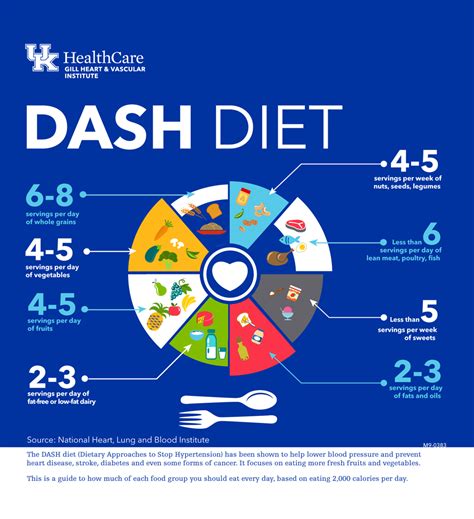The DASH diet, which stands for Dietary Approaches to Stop Hypertension, is a well-researched and widely recommended eating plan that was initially designed to help lower blood pressure without medication. Developed by the National Heart, Lung, and Blood Institute (NHLBI), this diet has evolved over the years to become a comprehensive approach to healthy eating, benefiting not just those with hypertension but also individuals seeking to adopt a balanced and nutritious lifestyle.
Origins and Evolution
The DASH diet was first introduced in the 1990s as part of a research study aimed at identifying dietary patterns that could help reduce blood pressure. The initial study compared three different diets: a control diet that was similar to what many Americans eat, a diet rich in fruits and vegetables, and the DASH diet, which emphasized whole grains, lean protein, low-fat dairy, and plenty of fruits and vegetables, while limiting saturated fat, cholesterol, and sodium. The results were remarkable, showing that the DASH diet could significantly lower blood pressure in just two weeks, an effect that was even more pronounced in individuals with hypertension.
Over the years, the DASH diet has undergone several iterations, including the DASH-Sodium trial, which further demonstrated the benefits of reducing sodium intake in addition to following the DASH dietary pattern. The diet’s success has led to its recommendation by numerous health organizations, including the American Heart Association, for the prevention and management of hypertension, as well as for overall health and wellness.
Key Components
The DASH diet is characterized by its emphasis on whole, unprocessed foods. The primary components include:
- Fruits and Vegetables: A variety of fruits and vegetables to provide fiber, vitamins, and minerals, and to help lower blood pressure.
- Whole Grains: Whole grain foods, such as brown rice, quinoa, whole wheat bread, and whole grain pasta, are preferred over refined or processed grains to provide fiber and nutrients.
- Low-Fat Dairy Products: Low-fat or fat-free dairy products, including milk, cheese, and yogurt, are recommended for calcium and protein without excessive saturated fat.
- Lean Protein: Poultry, fish, and beans are encouraged as lean protein sources to reduce saturated fat and cholesterol intake.
- Healthy Fats: Nuts, seeds, avocados, and olive oil are included for their health benefits, such as lowering LDL cholesterol and providing essential fatty acids.
- Low Sodium Intake: The diet recommends limiting sodium to less than 2,300 milligrams a day and further reduces it to 1,500 milligrams if possible, especially for those who are at risk for high blood pressure or are over the age of 50.
Benefits Beyond Blood Pressure Management
While the DASH diet was initially designed to combat hypertension, its benefits extend far beyond blood pressure management. Some of the additional benefits include:
- Weight Management: The emphasis on whole foods and portion control can help with weight loss and maintenance.
- Improved Heart Health: By reducing the intake of saturated and trans fats, cholesterol, and sodium, the DASH diet can help lower the risk of heart disease.
- Reduced Risk of Diabetes: The diet’s focus on whole, unprocessed foods can help regulate blood sugar levels and reduce the risk of developing type 2 diabetes.
- Certain Types of Cancer Prevention: Eating a diet rich in fruits, vegetables, and whole grains, as recommended by the DASH diet, may reduce the risk of certain cancers, such as colon, breast, and kidney cancers.
- Improved Bone Health: The inclusion of low-fat dairy products provides calcium and vitamin D, which are essential for bone health, potentially reducing the risk of osteoporosis and fractures.
Implementation and Flexibility
One of the reasons for the DASH diet’s popularity is its flexibility and ease of implementation. It is not a quick-fix diet but rather a long-term approach to healthy eating that can be adapted to suit different lifestyles and preferences. Individuals can follow the DASH diet by making gradual changes to their eating habits, starting with simple steps such as increasing their intake of fruits and vegetables, reducing sodium, and choosing whole grains over refined products.
Moreover, the DASH diet does not require specialized foods or supplements, making it accessible and affordable for most people. The focus on whole foods also allows for a wide range of flavors and textures, reducing the likelihood of boredom or feeling deprived, which are common challenges faced by those trying to adopt a new diet.
Conclusion
The DASH diet offers a well-balanced and sustainable approach to healthy eating, providing numerous benefits beyond its original purpose of lowering blood pressure. By emphasizing whole, nutrient-dense foods and limiting unhealthy components, the DASH diet serves as a valuable guide for individuals seeking to improve their overall health and reduce the risk of chronic diseases. Its flexibility, accessibility, and proven effectiveness make it an excellent choice for those looking to adopt a healthier lifestyle.
What are the primary benefits of the DASH diet?
+The DASH diet is primarily beneficial for lowering blood pressure and managing hypertension. However, it also offers additional benefits such as weight management, improved heart health, reduced risk of diabetes, and certain types of cancer prevention.
How does the DASH diet compare to other diets in terms of heart health?
+The DASH diet is highly regarded for its heart health benefits, ranking among the top diets for heart health due to its emphasis on reducing saturated fats, cholesterol, and sodium, while increasing the intake of fruits, vegetables, whole grains, and lean protein sources.
Can the DASH diet be adapted for individuals with dietary restrictions or preferences?
+Yes, the DASH diet can be adapted for individuals with dietary restrictions or preferences, such as vegetarian or vegan diets, by focusing on plant-based protein sources and dairy alternatives. It is also adaptable for gluten-free diets by choosing gluten-free whole grains.
The DASH diet stands out as a comprehensive and beneficial eating plan that not only helps manage hypertension but also contributes to overall health and wellness. Its emphasis on whole foods, flexibility, and proven benefits make it an excellent choice for individuals seeking a sustainable approach to healthy eating.


